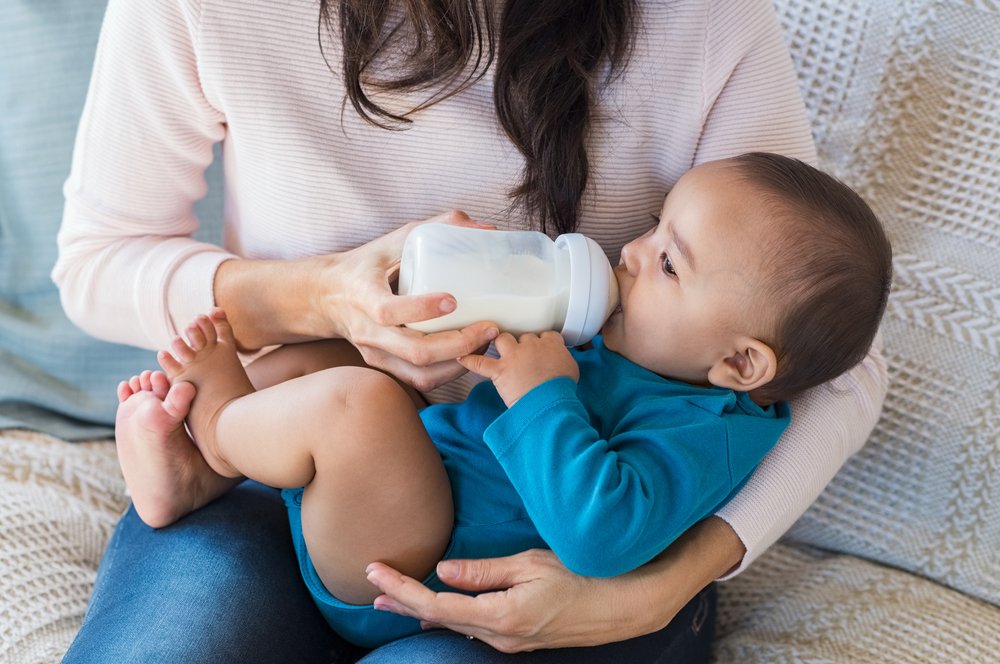Key points:
- The ideal amount of milk that a baby should consume will depend on their age, and each child’s needs will be different.
- Newborns tend to feed every 2-3 hours and consume between 1 and 2 ounces (30-60 ml) at each feed, while older babies may go 3-4 hours between feeds of 2 or 3 ounces (60-90 ml).
- The AAP recommends initially bottle-feeding newborns on demand and to listen to the baby’s hunger cues. Babies will begin to develop their schedule as they grow.
- After the first month, babies will drink on average 3 to 4 ounces (90–120 ml) every 4 hours. The amount will gradually increase by 1 ounce (30 ml) per month, with a maximum of about 7 to 8 ounces (210–240 ml).
Some advantages of bottle feeding your baby, instead of breastfeeding them, is that you can easily see and measure the amount of milk they are ingesting every day. But, do your know how many ounces should a baby eat?
If you decided to bottle feed your baby or they have grown and transitioned from breastfeeding to drinking from a bottle, this article will help you know the ideal amount of milk that your child has to consume according to their age.
First, it’s important to remember that each child is different, and, because of that, what a baby ingests is not necessarily the same amount as another baby of the same age. As your child grows, you’ll notice that sometimes they will be very hungry; while others, they eat less than usual. This is totally normal since each baby determines the ideal amount of milk according to their growth needs.
How many ounces should a baby eat at each stage of development?
The next information applies to babies that consume breast milk or formula.
Let’s start with the youngest. Newborn babies tend to bottle feed every 2-3 hours and consume between 1 and 2 ounces (30-60 ml) in each feed, while older babies may go 3-4 hours between feeds of 2 or 3 ounces (60-90 ml). However, it is most important to listen to your child’s hunger cues and speak with your pediatrician about their recommendations for how often and how much your baby should be eating. It is also common for babies consuming breast milk (either from the breast or in a bottle) to consume smaller volumes more frequently while formula-fed babies may consume larger volumes during each feed.
The AAP recommends initially bottle-feeding your newborn on demand, or whenever they cry because they’re hungry. As time passes, they’ll begin to develop a fairly regular timetable of their own.
A few common hunger cues our babies show us in the newborn phase include:
- Stirring, fidgeting, or stretching
- Opening their mouth
- Rooting and turning their head to look for a bottle or breast
- Bringing their hands to the mouth
- Crying (this is a late hunger cue, which may mean we’ve missed one of the earlier hunger cues noted above!)
If your baby has been sleeping for more than 4 hours, it’s best for you to wake them up to feed. This won’t alter their sleep; in fact, it will help your baby sleep better through the night since the naps are shorter.
After the first month, on average, your baby will drink around 3 to 4 ounces (90–120 ml) every 4 hours. This quantity will increase gradually as they grow by 1 ounce (30 ml) per month until they reach a maximum of about 7 to 8 ounces (210–240 ml). For example, around 6 months, your little one will drink 6 to 8 ounces (180-240 ml) 4 or 5 times a day. And since they will start eating solids once they are 6 months old, the way of measuring milk consumption will change.
On average, your baby should take in about 2 ½ ounces (75 ml) of formula a day for every pound (453 g) of body weight. However, there are high and low limits on how many ounces should a baby eat. Your little one should drink no more than 32 ounces (960 ml) of formula in twenty-four hours. Some babies have higher needs for sucking and may just want to suck on a pacifier after feeding. If your baby constantly seems to want more or less than this, discuss it with your pediatrician.
Each day, your little one will regulate the amount of milk they drink according to their current needs. If you notice that they are distracted while eating, they might be satisfied already. If they left some milk in the bottle, you should throw it out if you don’t use it again within that hour. On the contrary, if your child finishes the bottle but keeps making sounds with their mouth, they are probably still hungry. Prepare another bottle, even if they have already consumed what’s expected for their age. Check out our catalog to know how to correctly store and preserve the milk.
Remember that there are no established and prescribed amounts when bottle-feeding a baby. Don’t worry if your little one eats more or less than what we’ve said before; the nutritional needs of your child are unique. The important thing is that they grow in a healthy way, and this won’t be determined by the amount of milk they consume.
If you have any questions regarding how much and how often your baby should be eating, or if you have any concerns about your baby’s nutrition, feeding, or weight gain, please discuss this with your pediatrician!







